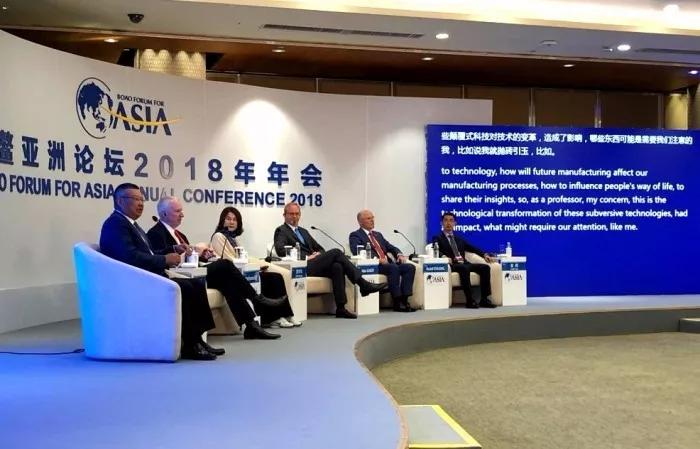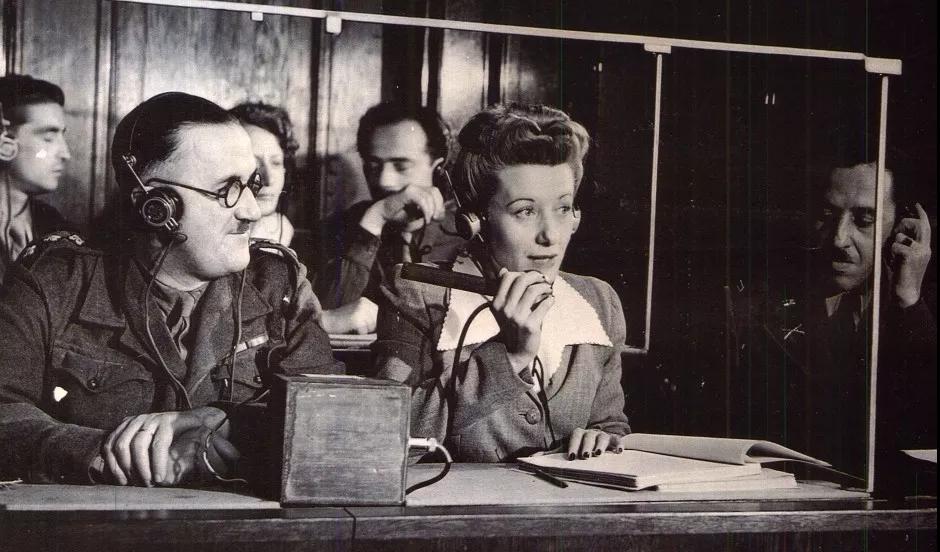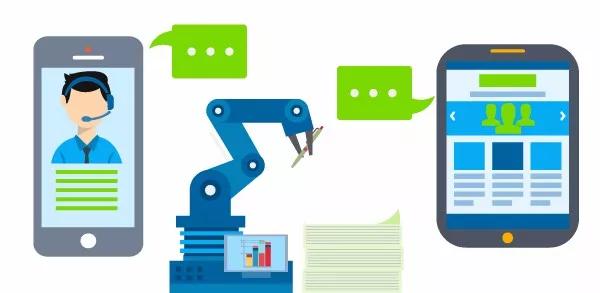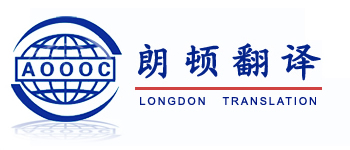今年博鳌亚洲论坛首次尝试使用AI机器同传技术,引发关注,但由于很多翻译呈现得并不理想,结果在业内引起争议。一时间,有人批评译文漏洞百出、准确率低,也有人力挺技术革新,称这是翻译技术勇敢迈出的第一步。

▲博鳌亚洲论坛2018年年会上使用AI同传技术(图片来源:环球科技)
那么,该如何看AI同传技术首次“替代”人工译员呢?这是AI替代人类的“第一枪”吗?本期“天下·译事”为大家提供一个观察视角↓
Over the few past years, the demand for real-time interpreting services has increased considerably. One major contributing factor for this phenomenon is the globalization of business, as it has increased the number of opportunities for international trade and opened up new markets for businesses all around the world.
在过去几年中,市场对实时口译服务的需求大大增加。造成这一现象的一大原因是商业全球化,因为全球化增加了国际贸易的机会,并为世界各地的企业开辟了新的市场。
In order to stay competitive and meet this increase in demand for interpreting services, developers have been working on technological solutions to meet the requirements for high-quality simultaneous interpreting, but can technology really replace human beings with regards to interpreting services?
开发人员为了保持竞争力以及满足口译服务需求的增长,一直在研究技术解决方案,以满足高品质同声传译的要求,但技术真的能代替人类完成口译服务吗?
翻译技术的进展

Real-time translation systems are available on the market which include applications that can be installed on smartphones, computers, or other devices connected to the Internet. The words of the speaker are transcribed by a computer server, which analyzes the content and selects the closest translation from a vast collection of phrase pairs in its database.
市面上已经有各种实时翻译系统,其中一些应用程序可以安装在智能电话、计算机或能够连网的其它设备上。讲话者的语句由计算机服务器转录,服务器对内容进行分析,并从其数据库中的大量短语对中选择最接近的翻译。
There are already a few machine interpreting solutions on the market today. Despite their growing popularity, apps and services such as these have received criticism for their inability to accurately convey the meaning of what is being said. Humans often use context to determine the meaning of words, and consider how individual words interact with each other.
目前市场上已经有一些机器口译解决方案。尽管这些应用程序和服务的使用范围越来越广,但由于其无法准确传达讲话内容的含义而遭到批评。人类经常根据语境来确定单词的含义,并思考每个单词之间是如何互相关联的。
拿谷歌翻译的一段法庭口译内容举例(西班牙语译英语):
Witness: Se me borró dónde quedó ese maldito cohete, pero si quieren saber, el pinche lana quedó en la cajuela del mueble.
Google Translate: I erased me where you got the damn rocket, but if you want to know, click the wool was in the trunk of furniture.(直译为:我擦除了我你在拿到该死的火箭的地方,但如果你想知道的话,点击羊毛就在家具的后备箱里。)
A real interpreter would have said something like: “I can’t remember where that damn piece ended up, but if you want to know, the damn dough ended up in the car trunk.”
人类口译员可能会翻译为:“我想不起来那该死的枪在哪儿,但是钱是在汽车后备箱里。”
As you can see, communication broke down quickly once the witness used a little slang. The witness gave a perfectly coherent answer (and this type of answer is entirely common in court testimony), but Google’s rendering garbled it beyond recognition.
可以看到,证人稍微说点俚语,交流就无法进行下去了。证人的回答条理十分清晰(这种回答在法庭证词中很常见),但谷歌的翻译结果却将其打乱,完全变了样。
One problem is that Google cannot consistently give a dependable translation; a potentially greater problem is that it takes an interpreter to parse out which renditions are correct.
一方面谷歌无法始终给出可靠的译文,另一方面或许更为关键,依然需要口译员从语法上分析哪些译文是正确的。
However, these combinations are in constant change owing to evolving human creativity.
不过,随着人类创造力的演进,人机结合的情形也在不断变化着。
所以说,技术能取代人工口译员吗?
Nevertheless, with all these technological advances, interpreter jobs will inevitably evolve, just as they have already over the years. The Nuremberg Trials are generally considered to have been the event that changed interpretation forever. Before The Nuremberg Trials, any kind of interpretation was done consecutively—talk first, and then wait for the interpreter to translate. In 1945, for the first time, interpretations were performed consecutively using a system of microphones and headsets to transmit the cacophony of languages.
各种技术在进步,口译职业的提升在所难免,多年以来一直如此。一般认为纽伦堡审判长久改变了口译行业,这场审判之前,所有口译都是交传形式,即讲者先发言,然后等口译员进行翻译。1945年首次采用麦克风和耳麦进行同传,尽管音质不佳。

In 2008, Livescribe launched its first “smart pen,” which featured an infrared camera just below the writing tip to record the pen’s movements, and a built-in microphone to pick up ambient sound. Handwritten notes are then synchronised with the sound recordings using a digital time signature for playback on demand. The Smartpen offers a ‘safety net’ of sound recording in consecutive interpretation settings where accuracy is key, such as healthcare and the justice system.
2008年Livescribe发布了首款“智能笔”,笔端下方的红外摄像机记录笔的动作,还有内置麦克风捕捉环境音,通过数字时值实现手写文字与声音记录的同步,供需要时回放。智能笔为同传的声音记录提供了安全保障,对同传来说,准确是关键,如医疗和司法领域。
From a didactic standpoint, the decisions and ethical dilemmas interpreters face on a daily basis are countless and the potential for disagreement regarding those decisions is great. Technology Mediated Dispute Resolution (TMDR) processes can be particularly useful when misunderstandings and conflicts arise. It’s also thanks to tech that all work is documented and thus available for follow-up and review.
从教育的角度来看,口译员每天面临的决策和伦理困境是数不胜数的,在这些决策上存在分歧的可能性很大。当出现误解和冲突时,技术介导的争端解决进程特别有用。这也要归功于技术,让所有工作都被记录下来,可供跟进和审查。

From our point of view, we believe that technology-assisted interpreting is more and more welcome. In its simplest application, smartphones, tablets, and online dictionaries are being put to good use, described by some as an “infallible information assistant” if personal knowledge comes up short. However, it should not be relied on completely, and human interpreters will always be required for certain nuances that may be almost impossible for even the most cutting edge technology to detect.
从我们的角度来看,我们认为技术辅助口译越来越受欢迎。在其最简单的应用中,智能手机、平板电脑和在线词典正被充分利用,在知识欠缺的情况下,有人把它描述为“可靠的信息助手”。然而,人们不应该完全依赖这项技术,对于某些即使是最尖端的技术也几乎不可能检测到的细微差别来说,人类口译员永远是必需的。

Leading providers adopt technological solutions when the time is right in order to gain a competitive advantage. Of course, machine interpretation is still in its infancy, and who knows what the next wave of innovation will bring. For now, though, I think we can safely say that human interpreters are irreplaceable.
行业领导者在时机合适时采用技术解决方案,以获得竞争优势。当然,机器翻译仍处于起步阶段,谁知道下一波创新潮将会带来什么?但现在,我想我们可以有把握地说,人类口译员是不可替代的。




